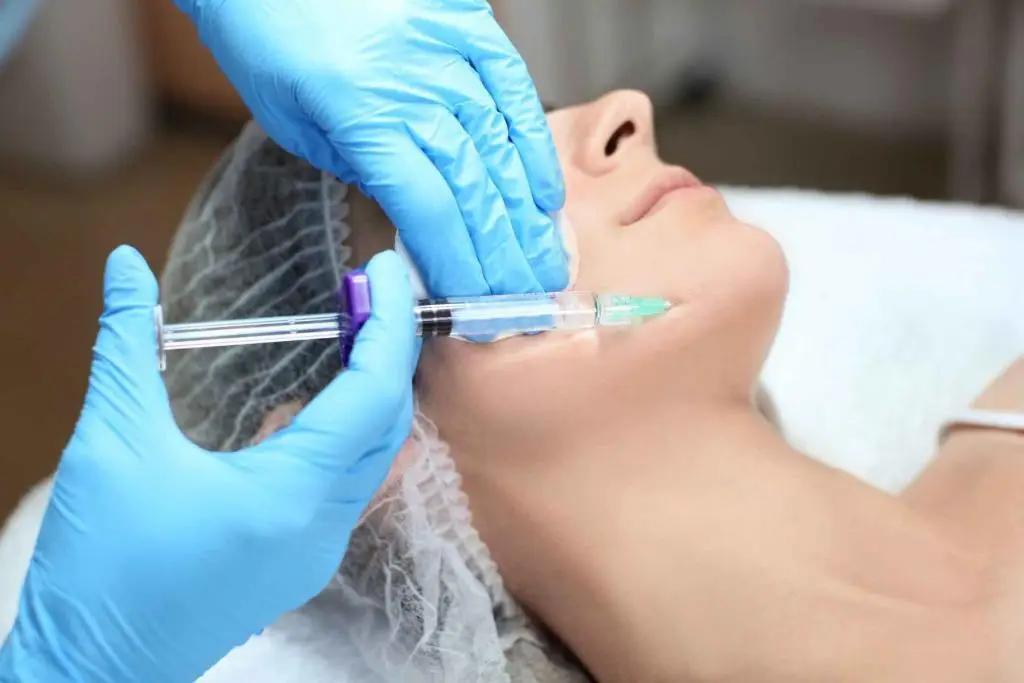Masseter Botox, an innovative application of injectable muscle relaxer, utilizes onabotulinumtoxinA, a neurotoxin renowned for its temporary paralysis of targeted muscles. While commonly employed to diminish the appearance of forehead wrinkles, this remarkable technique extends its influence to the masseter muscles near the cheekbones, yielding transformative effects on facial contouring and providing relief from facial pain. Discover more about this special treatment, including its multitude of advantages and potential side effects.
What is masseter Botox?
Situated alongside your face, the masseter muscle plays a pivotal role in facilitating the chewing process, connecting your lower jawbone to your cheekbone. When the remarkable substance known as Botox is skillfully administered into the masseter, this specialized treatment earns the moniker of “masseter Botox” or even “jaw Botox.” Leveraging the power of botulinum toxin, this innovative approach temporarily intercepts nerve signals within the masseter, rendering the muscle incapable of movement. As a result, a multitude of transformative effects can be achieved.

What is the masseter Botox used for?
Masseter Botox serves a diverse range of purposes, including:
- Teeth grinding management: Applying Botox to the masseter effectively assists in controlling bruxism, a condition characterized by teeth grinding.
- Alleviating jaw tension, pain, and clenching: Masseter Botox offers relief from discomfort caused by excessive jaw tension and involuntary clenching, enabling a more relaxed and comfortable state.
- Headache relief:Botox in the masseter muscles has been shown to relieve headaches, particularly those associated with tension and jaw-related issues.
- Sculpting a refined jawline: Through the precise administration of Botox, the contour of a square jaw can be delicately reshaped, resulting in a more harmonious and aesthetically pleasing facial appearance.
- Facilitating facial balance: Masseter Botox contributes to achieving a balanced and proportionate face shape by harmonizing the size and prominence of the masseter muscles with other facial features, yielding a more symmetrical and pleasing overall look.
What’s the procedure for getting masseter Botox?
Before the procedure
Before the masseter Botox procedure, you will have a consultation with a healthcare provider, during which they will discuss your objectives and address any concerns you may have. They will also thoroughly examine your jaw and facial structure to determine the specific injection sites and the amount of Botox.
The procedure will be performed in a doctor’s office, eliminating the need for a hospital visit.
During the procedure
During the procedure, you can anticipate the following steps:
- The healthcare professional will cleanse your skin meticulously to minimize the chances of infection. Sometimes, they might apply a topical anesthetic to numb the targeted area.
- A syringe containing the botulinum toxin will be prepared, equipped with a fine needle.
- Carefully, the needle will be inserted into your masseter muscle, and as the toxin is administered, the needle will be slowly withdrawn.
- If necessary, the same procedure may be repeated on the opposite side. The number of syringes required will depend on the specific condition being treated.
- Typically, the entire procedure lasts approximately 15 minutes.
After the treatment
Following the treatment, you can resume your regular activities without any required downtime or recovery period.
However, it is essential to avoid the following actions for the next 24 hours to prevent the potential spread of the toxin to other facial areas:
- Avoid rubbing or massaging the treated area.
- Refrain from applying excessive pressure to the treated area.
- Minimize strenuous physical exercise.
The complete treatment results will typically become evident within approximately one week. Some individuals may start noticing improvements as early as 1 to 3 days after the procedure.
It is essential to keep in mind that the effects of Botox are temporary and typically last between 3 to 4 months. You will need to undergo periodic repeat treatments to sustain the desired results.
What are the benefits of masseter Botox?
Reduces teeth grinding
Masseter Botox offers the following benefits:
Masseter Botox injections have shown efficacy in reducing teeth grinding, also known as bruxism. While traditional treatments for bruxism involve the use of mouthguards and lifestyle adjustments, Botox injections can be a more effective solution for severe cases.
By targeting the masseter muscle, the botulinum toxin weakens its activity, leading to relaxation of the jaw. Consequently, this prevents involuntary clenching of the jaw and teeth, alleviating symptoms such as:
- A sensation of tightness in the jaw.
- Pain experienced in the jaw, neck, or face.
- Tooth sensitivity or pain.
- Occurrence of dull headaches.
- Protection against tooth damage caused by grinding.
- Relief from ear pain associated with bruxism.
The unique advantage of using Botox for bruxism lies in its ability to directly address the muscular cause of teeth grinding, providing effective symptom relief.
Reduces symptoms of TMD
The temporomandibular joint (TMJ) plays a crucial role in facilitating chewing as it serves as a hinge connecting the lower jawbone to the skull. When issues arise with the TMJ, it is referred to as temporomandibular joint disorder (TMD), which often coexists with bruxism and masseter pain.
The application of Botox to the masseter muscle can yield therapeutic benefits for TMD by inducing muscle relaxation. This can help alleviate various TMJ-related symptoms, including:
- Jaw pain, which can range from mild discomfort to severe pain.
- Headaches are often characterized by tension or muscle strain in the jaw area.
- Protection against TMJ damage caused by excessive muscle activity or grinding.
- Improvement in the range of motion of the jaw, allowing for better jaw movement and reduced stiffness.
- Relief from pain experienced in the jaw, face, and ears, which may result from TMJ dysfunction.
- Prevention of jaw locking, where the jaw temporarily becomes stuck or difficult to open or close.
By targeting the masseter muscle, Botox injections can effectively address TMJ-related symptoms and provide relief for individuals experiencing the temporomandibular joint disorder.
Slims your face shape
The masseter muscles play a significant role in shaping the facial structure, and their size can contribute to a square-shaped face. For individuals desiring a slimmer facial appearance, masseter Botox injections are an option.
By administering Botox to the masseter muscles, their activity is weakened, reducing their size and volume. This effect helps create a more slender and aesthetically pleasing V-shaped jawline, contributing to a slimming effect on the face.
Commonly referred to as jaw reduction or masseter reduction, the application of Botox to the masseter muscles can effectively sculpt and enhance facial contours, providing individuals with the desired slimmer face shape they seek.

What are the potential side effects of masseter Botox?
While Masseter Botox is generally considered safe, like any medical procedure, it has potential side effects. These side effects may include:
- Discomfort or swelling at the injection site: Some individuals may experience mild pain or swelling in the area where the Botox was injected. This is typically temporary and resolves on its own.
- Bruising: Occasionally, minor bruising can occur at the injection site. It usually subsides within a few days or weeks.
- Headache: In rare cases, individuals may experience headaches following the procedure. If this occurs, it is typically mild and temporary.
- Some individuals might experience flu-like symptoms such as fatigue, muscle weakness, or mild fever. These symptoms are generally short-lived and should resolve on their own.
- Changes in facial expression: While extremely rare, there is a slight possibility of temporary asymmetry or a crooked smile due to the effect of Botox on the muscles. This effect is temporary and fades as the Botox wears off.
- Excessive drooling: In rare cases, individuals may experience temporary excessive saliva production or drooling. This side effect is typically short-lived and resolves on its own.
It is important to note that the occurrence of these side effects is generally minimal and transient. If you have any concerns about potential side effects, discussing them with your healthcare provider before undergoing the procedure is advisable.
Where can you find a qualified cosmetic surgeon for this procedure?
When considering Masseter Botox or any cosmetic procedure, it is crucial to collaborate with a qualified dermatologist or cosmetic surgeon to minimize the risk of complications and achieve your desired outcomes. To find a suitable surgeon, you can follow these steps:
- Seek recommendations: Consult your dermatologist or primary care doctor for a referral to a reputable surgeon experienced in Masseter Botox. They can provide valuable insights and guidance based on their professional network and knowledge.
- Utilize professional resources: The American Society of Plastic Surgeons offers a helpful tool called “Find a Surgeon,” which allows you to search for qualified professionals specializing in cosmetic procedures, including Masseter Botox.
During your initial consultation, take the opportunity to gather information and address any concerns you may have. Consider asking the following questions to gain a better understanding:
- Will Masseter Botox help me achieve my desired results?
- Am I an ideal candidate for Masseter Botox?
- How should I prepare for the procedure?
- Where will the procedure take place, and can you explain each step of the process?
- Are there any post-procedure restrictions or activities I should avoid?
- What can I expect in terms of appearance and results over time?
- Are there any risks or potential complications associated with Masseter Botox?
- How long have you been practicing, and do you have specific training in Masseter Botox?
- Can you provide before and after photos of previous patients who have undergone Masseter Botox?
- What is the estimated cost of the procedure, including any follow-up treatments?
Asking these questions will allow you to make an informed decision and ensure you are comfortable with the surgeon’s expertise and approach to the procedure.
Takeaway
The masseter muscle in the jaw and cheek region plays a crucial role in conditions such as severe bruxism or temporomandibular joint disorder (TMD). In such cases, opting for Botox injections in the masseter muscle can alleviate associated symptoms. Additionally, it can help contour the jawline and harmonize the overall facial shape.
To ensure optimal outcomes, it is vital to collaborate with a qualified cosmetic surgeon who possesses specific training and expertise in administering masseter Botox. By working with an experienced surgeon, you can have confidence that the procedure will be performed safely and accurately, maximizing the potential benefits and minimizing risks.

